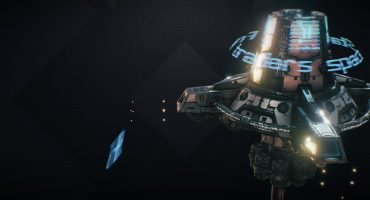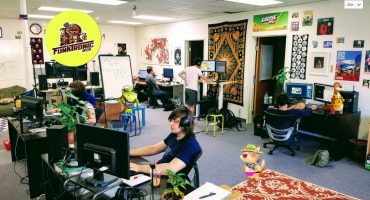Hi my name is Karolis Dzevecka and I’m the Vehicle Assets Producer at MRG Team. We are a subsidiary of Mail.ru and are currently residing in Moscow. We’re mostly known for our work on such RPG games as Skyforge and Allods Online, but we relish the opportunity to get into the world of modern tanks and armored vehicles in general in Armored Warfare.
Armored Warfare is a free-to-play massively multiplayer online tactical military video game that puts you in control of modern tanks or other classes of armor, features great visuals, dynamic destructible environments, customizable vehicles and intense team-based gameplay, where players work to crush each other with the power of modern combat vehicles.
The core of its gameplay is relatively simple to learn (but difficult to master!). Armored Warfare was not conceived as a niche hardcore simulator, but as a relaxing game anyone can get into. At the same time, our visual modeling team responsible for the 3D models strives for maximum visual and historical accuracy of each vehicle that is available to our audience. Our goal is to keep the experience casual, but also to deliver as accurate a visual experience as possible.
To achieve that, we put great effort into modeling of the in-game tanks – the engine Armored Warfare uses, CryEngine 3, is certainly a powerful tool and our team of more than a dozen modelers and effects specialists constantly pushes its limits by introducing new features from later CryEngine iterations that weren’t available in its stock version (such as the new shaders we’ve recently introduced). This engine was initially selected because it was the best choice for the type of battleground scale that we were going for (the main Armored Warfare mode consists of 15 versus 15 vehicle battles on roughly 1.5km x 1.5km battlefields) and was available by the time the development started five or six years ago.
The entire process of adding a new vehicle to the game lasts approximately three to four months, depending on the model difficulty. When a vehicle is selected for implementation, the first step of the process is to create a document the modeling team will use to create the vehicle model. This document is called a “workbook” and we are employing several military experts (some with real life armored vehicle experience) who collect the necessary information for us. Hundreds of photographs are assembled into the document – every possible angle of each vehicle is examined to make sure that no mistakes are made during the modeling process. Once all the available images are compiled into the document, it is then passed to the modeling team.
Our Armored Warfare modelers (both 3D and 2D experts) start with a basic (raw) geometry model (called a Blockout), using an excellent piece of software called Maya.
Over the course of model creation, details are added to the upcoming model and a high polygon version (consisting of many hundreds of thousands of polygons) is assembled. While incredibly realistic, this model would unfortunately be too much to handle even for modern PCs – the finalized version of Armored Warfare models is therefore much more manageable with each vehicle in the game consisting of 35 thousand up to 50 thousand polygons. This number naturally reflects the evolution of GPU systems and their availability to wide public – our free to play model requires a large audience, which means that we cannot make the game in the level of details that would be suitable only for the very best of PCs.
Instead, our goal is to make the game look great for everybody and – like any other developers – we have to make some concessions to achieve it (for example by using a band model for vehicle tracks instead of modeling every track link separately).
On the other hand, a tank MMO is a multi-year project. Since the Open Beta launch of Armored Warfare, the hardware situation has improved and we respond to that fact by overhauling some of our older models to look better (for example by increasing their polygon count).
Of course, polygons aren’t the only thing that matters – that’s where our texture specialists come in, using another piece of software called Substance Painter. It allows us to reach high visual fidelity of each model. We use Specular/Gloss Physically Based Rendering with some engine-default HRD lighting with additional supporting lights included. Almost all post-processing filters are used at low intensity.
What follows is the creation of the vehicle’s physical model, sometimes called Collision Model.
The vehicles in Armored Warfare consist of two models – the visual model (the graphics the players see) and the collision model (a simplified representation of the vehicles used to calculate hits, misses and penetrations by the game server). Compared to the real visual model, the collision model has but a fraction of polygons. There are two reasons for this simplification:
- It reduces the load on the Armored Warfare servers
- More importantly, it makes the game more comprehensible to players
To give an example for the latter point – imagine the Armored Warfare collision model was as detailed as the visual model.
Every little bit of metal and – even surface irregularities in extreme cases – would affect shell impact, resulting in much less predictable gameplay: the shell could for example ricochet off after hitting a tiny bit of metal welded to the tank front (towing hook for example).
While such randomness does happen in real life, it would make for very poor gameplay as players need to be able to sufficiently predict what their shell will do. A collision model that is too detailed would eventually result in many cases of outrageous random shots where a shell ricochets off small parts of armor details into sensitive tank areas. We do not want such “accidents” to occur often, so we have opted to simplify the armor model even though CryEngine does support a much higher level of collision model detail.
Each vehicle’s collision model is split into multiple zones. Each zone has a number assigned to it, representing the armor thickness in millimeters (before the armor materiel modifier). The entire impact mechanism is resolved by the server when a shell collides with this simplified model. Armored Warfare includes many types of armor – spaced armor, cage armor, ERA, you name it. Each of them is included in the collision model as well as the visual model. Naturally, both models have to be in perfect sync – there is nothing more frustrating for players than to fire at an enemy only to see a shell pass right through it.
When it comes to Sketchfab, we are using the 3D models on our website for both advertising and information via a special promotion page interface. As an example, here’s a page belonging to the recently introduced Irish-themed Challenger 1 Fionn Main Battle Tank. As you can see, its model, uploaded on our Sketchfab account, is seamlessly integrated into the web page design and you can access it directly by clicking on the “360 degrees 3D model” button on the main image, allowing players to inspect the vehicle they are about to obtain in detail.
The page also features information about the vehicle such as its armor level, firepower, mobility and much more. For players who are interested in its history, there is a short text description of its development as well as its performance in the game.
There are currently over two hundred vehicle models in the game already – a lot of work, love and care have been poured into Armored Warfare. We hope that our players enjoy it as much as we enjoy creating it for them!
For more information about Armored Warfare, please:
- Visit the Armored Warfare Website
- Follow us on Facebook
- Follow us on Twitter
We’ll see you on the battlefield!







